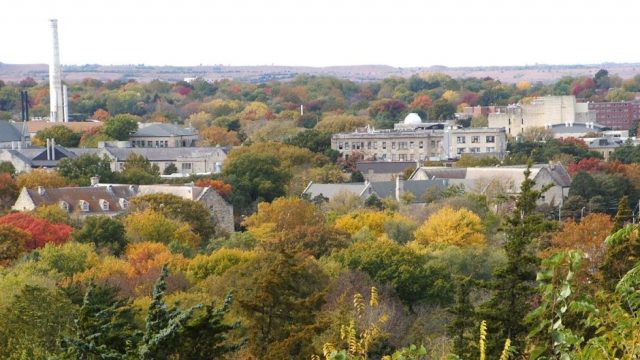Kansas college towns rank poorly in recession recovery

COLLEGE TOWN: Manhattan and Lawrence, home to two of Kansas’ largest state universities, bring up the rear in terms of growth following the economic recession.
By Travis Perry │ Kansas Watchdog
OSAWATOMIE, Kan. — Some of Kansas’ college towns aren’t faring as well as other Sunflower State cities in the post-recession recovery.
A recent examination of economic factors surrounding Metropolitan Statistical Areas — major cities and their surrounding regions — shows that not only do Lawrence and Manhattan bring up the rear in statewide rankings, but they also find themselves in a hole nationwide, too.
The revelation is detailed in a recent report compiled by authors Tom Gray and Robert Scaramalia for the Manhattan Institute’s Center for State and Local Leadership. While the researchers’ primary focus was on the 100 largest MSAs, which includes both Wichita and Kansas City, the duo also ranked all 357 economic regions nationwide.
Manhattan clocked-in at 17th from the bottom, while Lawrence was ranked as the seventh-worst performing MSA in the country.
Gray and Scaramalia looked at three specific factors — personal income, gross domestic product and private sector jobs — to determine how a city was recovering from the nation’s economic recession. Here’s a look at how all of Kansas’ metropolitan regions fared:
Kansas City, MO-KS – 194th overall
- Per Capita GDP – 123rd
- Per Capita Personal Income – 256th
- Private Sector Employment – 175th
Wichita – 225th overall
- Per Capita GDP – 98th
- Per Capita Personal Income – 181st
- Private Sector Employment – 337th
Topeka – 259th overall
- Per Capita GDP – 223rd
- Per Capita Personal Income – 261st
- Private Sector Employment – 211th
Manhattan – 340th overall
- Per Capita GDP – 266th
- Per Capita Personal Income – 344th
- Private Sector Employment – 340th
Lawrence – 351st overall
- Per Capita GDP – 333rd
- Per Capita Personal Income – 328th
- Private Sector Employment – 336th
Gray told Kansas Watchdog the report excluded public jobs because private sector employment is where money and growth is generated.
“This shows the wealth being generated by the private economy, and it pays for the public economy,” Gray said.
Lawrence and Manhattan’s heavy reliance on state universities and government employment could have impacted them negatively in this regard.
“Betting on government has not been a winning strategy for most MSAs lately. With a few exceptions, income earned in the public sector increased by single digits, if it rose at all, from 2009 to 2012,” the authors wrote. “This was a period of retrenchment in state and local spending and, after the 2009 stimulus package ran its course, in the federal government as well.”
“Because government spending is pretty much static, the larger percentage you have of that category, even if you have growth on your private side it’s going to be overall less,” Gray said.
He added that, because universities helped shelter communities against the full force of the economic recession, they may not be seeing much growth simply because not as much was lost following the 2008 collapse.
According to the Bureau of Labor Statistics, 31 percent of the Lawrence workforce is employed by the government, while in Manhattan the figure is more like 37 percent. That’s significantly higher than the 15 percent in Kansas City, 14 percent in Wichita and 24 percent in the state capital, Topeka.
Contact Travis Perry at travis@kansaswatchdog.org, or follow him on Twitter at @muckraker62. Like Watchdog.org? Click HERE to get breaking news alerts in YOUR state!







